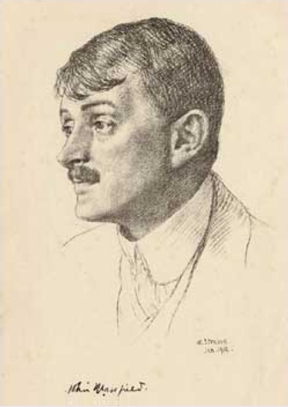John Masefield, poet 1878 - 1976

John Masefield was the third of six children born to George Edward Masefield, a solicitor working in the family firm in Ledbury. He was born on 1st June 1878 in a house called ‘The Knapp’ in The Homend, Ledbury. His grandfather, also named George, had moved down to Ledbury from Shropshire and married Frances Mary Holbrook, the daughter of the local solicitor, whose practice George subsequently took over around 1930. They lived at The Priory but John’s father and mother, George Edward and Caroline (who was a clergyman’s daughter) lived at the Knapp. She died in 1884 shortly after giving birth to his sister, Norah. and fourteen months later in 1885, both of John’s grandparents died. In 1890, his father suffered a mental breakdown and died a year later when John was only 12.
An uncle and aunt, living at The Priory in Ledbury, brought him up and he was sent as a boarder to King’s School in Warwick (now known as Warwick School). His aunt arranged for him to enrol as a cadet on ‘HMS Conway’ which was a naval training school on board a 19th-century wooden battleship based in Liverpool. In 1894 he joined the Merchant Navy at the age of sixteen and served his apprentice as a crewman. After completing an Atlantic voyage, he deserted his ship and became a vagrant in the United States of America.1 His nephew, Bill Masefield, recalls: “He went on, for example, on a ship round Cape Horn and he was so ill, physically ill, not just sick but ill, that he was invalided home. Got over that and got another berth on a ship to New York and that was the end of his sea-going. People say he ran away to sea, I’ve always said he ran away from the sea”.2
On returning to England, at the age of 23, he met and married Constance Crommelin who was 35, Irish, a Cambridge graduate and a mathematics teacher. She was a perfect match for Masefield despite the difference in age and the couple had two children, a son and a daughter. He was made Poet Laureate in 1930.1
In 1952, aged 74, he began a correspondence with Audrey Napier-Smith whom he nicknamed ‛Reyna’ (pronounced ‘Ra-eena’). An extract from his letters shows the wide range of topics they discussed:
Letter 552, 1965 In the presence of fame.
‘. . . I have been reading in Chopin’s letters of late, written in his last years: while on an English
visit. He saw something of Miss Jenny Lind, a lovely Swedish singer, in about 1838, for she was singing here then.
This gave me a thrill & a shock for, when I began to go to Church in Ledbury, about 1886, Miss Lind was often in the pew in front of me, & I could have leaned over the pew-top & prodded her had I had an umbrella.
I suppose that I heard her sing, but cannot remember.
It was long ago; & at the side of her pew was a pillar of a late Gothic period. On this pillar, a man of genius, in the 15th century, had carved, with power, a startled man’s face (nothing else) that haunted me a good deal. This pillar rose from within her pew.
In repairs to the church in 1891 (or 2) this face disappeared.’3
His wife, Constance, died in 1960 aged 93 and, on 12th May, 1967, John Masefield died. He was cremated and his ashes interred at Poets’ Corner in Westminster Abbey, London.4
Sources:
1 Wikipedia at http://en.wikipedia.org/wiki/John_Masefield Accessed 31 May 2007
2 Oral History Interview with Bill Masefield, 12 October 2006.
Courtesy of England's Past for Everyone, Ledbury project.
3 John Masefield - Letters to Reyna - ed. William Buchan
Published by Buchan & Enright, London (1983) ISBN 0 907675 14 X
4 Britain Unlimited http://www.britainunlimited.com/Biogs/Masefield.htm
Accessed 31 May 2007
